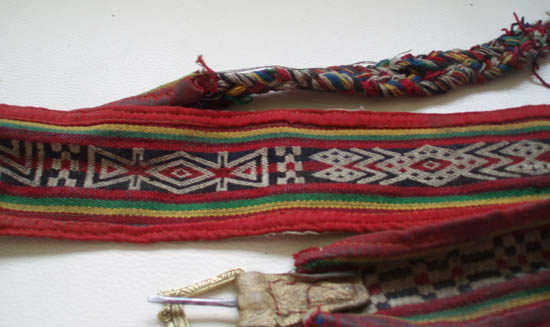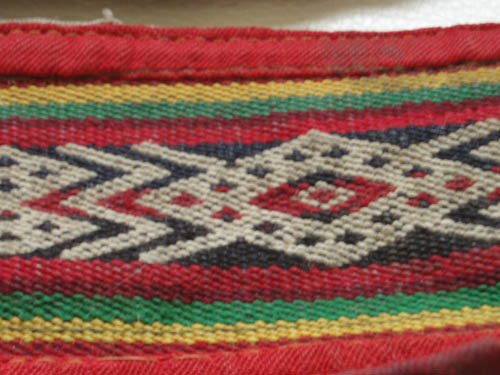Colours of Life: A Perspective from Tibet (Part 2)
by Jaina Mishra
C. SASHES & BELTS
Two all wool sashes that are worn high at the waist.





Here is another belt, one of several I saw, which have metal adornments. The metal may be silver or some alloy known as white copper. The fasteners are made of leather. Purses and flintstone lighters hang from these loops alongside bullet cases.


D. ANIMAL TRAPPINGS
Below is the horse that drove the cart that took me to the Mt Qoomalongma (Everest is known by this name at the Tibet end) Base Camp.

Look at the beautifully woven things he gets to wear!
Am not sure if this belt I got in Lhasa was meant for man or horse, but I was given to believe that this is for humans – though it looks very much like my horse’s belt.


Below are some other animal bands for yak or horses that I saw on the street. These woven belts seem to be similar to ones I have seen in the Kutch region in India.

The ones on the left, and the
black one on the horse, appear to be made with the “ply splitting” technique, found in
India, Egypt, Turkey, Greece, Nepal, and
Japan.
E. HAIR TEXTILES
An interesting feature is that both men and women wear their hair long (really, really long) and tie it up using a braid – which is usually red but other colours are not uncommon. Although none of these are old, they still look wonderful.



I am sure if we were to search deep enough, we’d find the older equivalents of these very traditional accessories. Girls from Khampa Eastern Tibet, braid their hair into 108 plaits, a religiously significant number for Buddhists.
Hair ornaments in metal, turquoise and coral.


F. BAGS AND POUCHES
Bags form an important item of their person – these are usually tied up as a pouch (seen in the next bag) and slung over a shoulder. Like a bagface in Persia would be slung over across the back of the animal, here, the bag is slung across the shoulder of the man or woman, with two equal halves usually, one for the front and one for the back. An example of an old bag with some leather bits sewn on for strength. The intricate twining of the rope and the fringe – may suggest its age.






An unusual 3 pouch bag ( extremely dirty but I am scared to wash or even touch it!)


